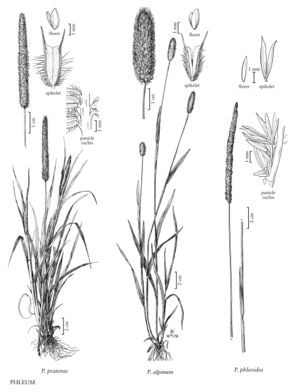Difference between revisions of "Phleum pratense"
FNA>Volume Importer |
imported>Volume Importer |
||
| (5 intermediate revisions by 2 users not shown) | |||
| Line 4: | Line 4: | ||
|publications= | |publications= | ||
|common_names=Timothy;Fleole des pres;Phleole des pres;Mil | |common_names=Timothy;Fleole des pres;Phleole des pres;Mil | ||
| + | |special_status={{Treatment/ID/Special_status | ||
| + | |code=I | ||
| + | |label=Introduced | ||
| + | }} | ||
|basionyms= | |basionyms= | ||
|synonyms={{Treatment/ID/Synonym | |synonyms={{Treatment/ID/Synonym | ||
|name=Phleum pratense var. nodosum | |name=Phleum pratense var. nodosum | ||
| − | |authority= | + | |authority= |
| + | |rank=variety | ||
}} | }} | ||
|hierarchy=Poaceae;Poaceae subfam. Pooideae;Poaceae tribe Poeae;Phleum;Phleum pratense | |hierarchy=Poaceae;Poaceae subfam. Pooideae;Poaceae tribe Poeae;Phleum;Phleum pratense | ||
| Line 19: | Line 24: | ||
-->{{Treatment/Body | -->{{Treatment/Body | ||
| − | |distribution=Conn.;N.J.;N.Y.;Wash.;Del.;D.C;Wis.;Alta.;B.C.;Greenland;Man.;N.B.;Nfld. | + | |distribution=Conn.;N.J.;N.Y.;Wash.;Del.;D.C.;Wis.;Alta.;B.C.;Greenland;Man.;N.B.;Nfld. and Labr.;N.S.;N.W.T.;Ont.;P.E.I.;Que.;Sask.;Yukon;W.Va.;Pacific Islands (Hawaii);Mass.;Maine;N.H.;R.I.;Vt.;Fla.;Wyo.;N.Mex.;Tex.;La.;Tenn.;N.C.;S.C.;Pa.;Calif.;Idaho;Mont.;Va.;Colo.;Alaska;Ala.;Kans.;N.Dak.;Nebr.;Okla.;S.Dak.;Ark.;Ill.;Ga.;Ind.;Iowa;Ariz.;Md.;Ohio;Utah;Mo.;Minn.;Mich.;Nev.;Miss.;Ky.;Oreg. |
|discussion=<p><i>Phleum pratense</i> grows in pastures, rangelands, and disturbed sites throughout most of the mesic, cooler regions of North America. Originally introduced from Eurasia as a pasture grass, it is now well established in many parts of the world, including the Flora region. North American plants belong to the polyploid <i>Phleum pratense</i> L. subsp. pratense, which differs from the diploid <i>P. pratense</i> subsp. bertolonii (DC.) Bornm. in having obtuse ligules. Depauperate specimens of <i>P. pratense</i> are hard to distinguish from <i>P. alpinum</i>.</p> | |discussion=<p><i>Phleum pratense</i> grows in pastures, rangelands, and disturbed sites throughout most of the mesic, cooler regions of North America. Originally introduced from Eurasia as a pasture grass, it is now well established in many parts of the world, including the Flora region. North American plants belong to the polyploid <i>Phleum pratense</i> L. subsp. pratense, which differs from the diploid <i>P. pratense</i> subsp. bertolonii (DC.) Bornm. in having obtuse ligules. Depauperate specimens of <i>P. pratense</i> are hard to distinguish from <i>P. alpinum</i>.</p> | ||
|tables= | |tables= | ||
| Line 29: | Line 34: | ||
-->{{#Taxon: | -->{{#Taxon: | ||
name=Phleum pratense | name=Phleum pratense | ||
| − | |||
|authority=L. | |authority=L. | ||
|rank=species | |rank=species | ||
| Line 36: | Line 40: | ||
|basionyms= | |basionyms= | ||
|family=Poaceae | |family=Poaceae | ||
| − | |distribution=Conn.;N.J.;N.Y.;Wash.;Del.;D.C;Wis.;Alta.;B.C.;Greenland;Man.;N.B.;Nfld. | + | |illustrator=Linda A. Vorobick;Cindy Roché;Hana Pazdírková |
| + | |illustration copyright=Utah State University | ||
| + | |distribution=Conn.;N.J.;N.Y.;Wash.;Del.;D.C.;Wis.;Alta.;B.C.;Greenland;Man.;N.B.;Nfld. and Labr.;N.S.;N.W.T.;Ont.;P.E.I.;Que.;Sask.;Yukon;W.Va.;Pacific Islands (Hawaii);Mass.;Maine;N.H.;R.I.;Vt.;Fla.;Wyo.;N.Mex.;Tex.;La.;Tenn.;N.C.;S.C.;Pa.;Calif.;Idaho;Mont.;Va.;Colo.;Alaska;Ala.;Kans.;N.Dak.;Nebr.;Okla.;S.Dak.;Ark.;Ill.;Ga.;Ind.;Iowa;Ariz.;Md.;Ohio;Utah;Mo.;Minn.;Mich.;Nev.;Miss.;Ky.;Oreg. | ||
|reference=None | |reference=None | ||
|publication title= | |publication title= | ||
|publication year= | |publication year= | ||
| − | |special status= | + | |special status=Introduced |
| − | |source xml=https:// | + | |source xml=https://bitbucket.org/aafc-mbb/fna-data-curation/src/200273ad09963decb8fc72550212de541d86569d/coarse_grained_fna_xml/V24/V24_946.xml |
|subfamily=Poaceae subfam. Pooideae | |subfamily=Poaceae subfam. Pooideae | ||
|tribe=Poaceae tribe Poeae | |tribe=Poaceae tribe Poeae | ||
Latest revision as of 16:26, 11 May 2021
Plants perennial; loosely to densely cespitose. Culms (20) 50-150 cm, usually erect, lower internodes frequently enlarged or bulbous. Sheaths of the flag leaves not inflated; auricles occasionally present, incon¬spicuous; ligules 2-4 mm, obtuse to acute; blades to 45 cm long, 4-8(10) mm wide, flat. Panicles (3)5-10(16) cm long, 5-7.5(10) mm wide, 5-20 times as long as wide, not tapering distally; branches adnate to the rachises. Glumes 3-4 mm, sides usually puberulent, keels pectinate-ciliate, apices awned, awns 1-1.5(2) mm; lemmas (1.2)1.7-2 mm, about 1/2 as long as the glumes, usually puberulent; anthers 1.6-2.3 mm. 2n = 42 (21, 35, 36, 49, 56, 63, 70, 84).
Distribution
Conn., N.J., N.Y., Wash., Del., D.C., Wis., Alta., B.C., Greenland, Man., N.B., Nfld. and Labr., N.S., N.W.T., Ont., P.E.I., Que., Sask., Yukon, W.Va., Pacific Islands (Hawaii), Mass., Maine, N.H., R.I., Vt., Fla., Wyo., N.Mex., Tex., La., Tenn., N.C., S.C., Pa., Calif., Idaho, Mont., Va., Colo., Alaska, Ala., Kans., N.Dak., Nebr., Okla., S.Dak., Ark., Ill., Ga., Ind., Iowa, Ariz., Md., Ohio, Utah, Mo., Minn., Mich., Nev., Miss., Ky., Oreg.
Discussion
Phleum pratense grows in pastures, rangelands, and disturbed sites throughout most of the mesic, cooler regions of North America. Originally introduced from Eurasia as a pasture grass, it is now well established in many parts of the world, including the Flora region. North American plants belong to the polyploid Phleum pratense L. subsp. pratense, which differs from the diploid P. pratense subsp. bertolonii (DC.) Bornm. in having obtuse ligules. Depauperate specimens of P. pratense are hard to distinguish from P. alpinum.
Selected References
None.
